August 24, 2012
Air Date: August 24, 2012
FULL SHOW
SEGMENTS

Paul Ryan’s Environmental Record
/ Steve CurwoodView the page for this story
Mitt Romney's energy plan promises more energy production through opening more areas to offshore oil and gas drilling, building the Keystone XL pipeline, and speeding up drilling permits. The environmental priorities of Congressman Paul Ryan, the GOP vice presidential pick, seem closely aligned with Romney's. Navin Nayak, the League of Conservation Voters head of campaigns, tells host Steve Curwood that Rep. Ryan has ties to the oil and gas industry and has voted against renewable energy subsidies during his reign in Congress. (06:40)
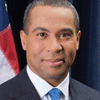
Power Shift - Massachusetts Energy Conservation
/ Jeff YoungView the page for this story
Grades are in, and Massachusetts leads the pack on energy conservation efforts. Living on Earth's Jeff Young looks into the state's history of efficiency initiatives, including some started by the Mitt Romney. (08:15)

Wastewater to Energy
/ Ashley AhearnView the page for this story
King County in Washington wants to be among the first regions in the nation to tap wastewater to use for energy in buildings. Ashley Ahearn of the public media collaborative Earthfix describes how it would work. (03:50)
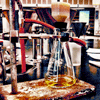
The Chemical Internet
/ Steve CurwoodView the page for this story
The invention of the Internet revolutionized the world. Now, a new type of network -- a chemical internet -- could fundamentally transform the chemical world we live in. Host Steve Curwood talks with Bartosz Grzybowski, professor of chemistry at Northwestern University in Evanston, Illinois, who created a chemical internet called Chematica which he believes could change how drugs are made. (07:40)

Bounty
/ Mark Seth LenderView the page for this story
In nature, life and death sometimes go hand in hand. So discovered writer and photographer Mark Seth Lender as he witnessed polar bears devouring a Beluga whale that washed ashore in Hudson Bay, Canada one summer day. (02:00)

Science Note: Turning up the volume on the mating dance
/ Christy PereraView the page for this story
The peacock is notorious for its unique mating display, where it raises up its ornate eye-spotted tail and shakes. Now, new research tells us humans can't quite experience the full show. Christy Perera reports. (02:00)

The Legacy
/ David SuzukiView the page for this story
Over the span of a lifetime, the world's population has tripled and consumption has become a way of life. David Suzuki reflects on these changes in his book "The Legacy: an elder's vision for our sustainable future." He tells host Steve Curwood that the path to a sustainable future is to stop elevating economy over ecology and to start imagining a brighter future. (16:30)
Show Credits and Funders
Show Transcript
Host: Steve Curwood
Guests: Navin Nayak, Bartosz Grzybowski, David Suzuki
Reporters: Ashley Ahearn, Jeff Young, Mark Seth Lender, Christy Perera
Notes:
(THEME)
CURWOOD: From Public Radio International - this is Living on Earth.
(THEME)
CURWOOD: I'm Steve Curwood.
Republican presidential contender Mitt Romney has revealed a comprehensive energy plan that would boost biofuels and offshore oil drilling, and give more power over oil and gas drilling rules to the states. Also, we look at the environmental record of vice-presidential hopeful Paul Ryan.
NAYAK: He is not a supporter of renewable energy. He's very fond of talking about not wanting to pick winners and losers. And at the same time he's been a pretty big proponent of providing billions of dollars in tax breaks to oil companies.
CURWOOD: And, a county in Washington State wants to be among the first in the U.S. to capture warm wastewater and extract its energy.
ISRAEL: We flush a lot of hot water, a lot of energy, down the drain and you can see it right here. We're trying to figure out a way of proving that you can capture that and use it in buildings."
CURWOOD: That and more this week on Living on Earth. Stick around!
[THEME]
PRI ANNOUNCER: Support for Living on Earth comes from the National Science Foundation and Stonyfield Farm.
Paul Ryan’s Environmental Record
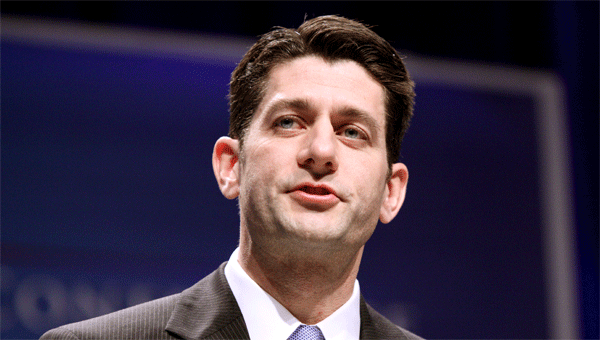
(Photo: Wikimedia/Gage Skidmore)
CURWOOD: From the Jennifer and Ted Stanley Studios in Boston, this is Living on Earth. I'm Steve Curwood.
As the national political season heads into high gear, Republican Mitt Romney has unveiled a comprehensive energy package to end dependence on foreign oil by 2020.
The Romney plan ramps up biofuel production, opens up Alaska's Arctic National Wildlife Refuge for oil drilling, approves the Keystone Pipeline, and gives states the right to regulate drilling on federal lands.
ROMNEY: On federal land, the permitting process to actually drill and get oil or gas is extraordinarily slow. Now interestingly, on state lands and private lands, state regulators have streamlined their permitting process; they've found a way because we compete, states do with one another, they found a way to do the job in a more efficient way. So for instance, in North Dakota is takes ten days to get a permit for a new well. In Colorado it takes 27 days. That's to get on state land a permit, or private land. But do you know how long it takes the federal government regulators to get your permit on federal land? On average three hundred and seven days. So here's what I'm going to do: I'm going to have the states take responsibility for the permitting process on federal lands.

(Photo: Wikimedia/James Currie)
[APPLAUSE]
CURWOOD: Governor Romney speaking on his energy plan. We now take a look at the environmental voting record of the GOP vice presidential hopeful, Wisconsin Congressman Paul Ryan. As he's served in Congress over the past decade, Mr. Ryan has gotten high marks among Republicans as a top leader for the cause of fiscal conservatism and budgetary management. Paul Ryan is also known as an avid outdoorsman and mountain biker. But when it comes to his voting record on the environment, the League of Conservation Voters has far less praise.
Joining us now is the senior vice president and head of Campaigns at the League of Conservation Voters, Navin Nayak. Welcome to Living on Earth.
NAYAK: Hey Steve
CURWOOD: So what kind of score did you give Congressman Ryan?
NAYAK: The Congressman has been in office for quite a while now and unfortunately his record consistently gets worse. He does have a lifetime score in the twenties on our national environmental scorecard but in 2011 he just scored a 3 per cent, meaning he only voted with the environment or for the pro environment position 3 per cent of the time
CURWOOD: Let's go over Congressman Ryan's record, he gets kudos from your organization for some votes that he's taken regarding the national forest, Tongass National Forest. What was that vote all about?
NAYAK: There's been a few votes historically - I think when Congressman Ryan came to Washington he really had a commitment to being a fiscal conservative and thought that there was a lot of wasteful government spending and there were issues related to the environment like subsidizing building of roads in national forests that he actually voted right on and agreed that we shouldn't use tax-payer dollars to build roads in our national forests just for logging or other purposes. So historically we've gotten him on those kinds of votes but those, unfortunately have been few and far between.
CURWOOD: What's his position been on renewable energy?
NAYAK: You know unfortunately this has been one place where Congressman Ryan has been unfortunately consistent. He is not a supporter of renewable energy. And I think that it speaks to the contradiction in a lot of words he's been pushing in the campaign. He's very fond of talking about not wanting to pick winners and losers. But he has consistently opposed investing in clean energy, whether it's production tax credit... investment in clean energy. And at the same time he's been a pretty big proponent of providing billions of dollars in tax breaks to oil companies. So basically every time he's had a vote on clean energy he's voted the wrong way and he's voted to oppose the industry.
CURWOOD: Now you say from your perspective he's voted the wrong way, but he's a fiscal conservative. He voted against the US spending $50 million to put more roads into the Tongass to get $500,000 in fees back, protecting the tax-payer. He is saying, look renewable energy is expensive. We shouldn't have to have federal subsidies to do this. Let the market do this.
NAYAK: It is one thing if you are consistent and you just generally oppose federal subsidies period. But for him to propose a budget, which is a part of the Ryan plan, that provides $40 billion in tax breaks to oil companies--the richest companies in the world, and I think that all tax-payers and all voters across the country can agree that that is the one industry that doesn't need federal support anymore. Yet he's more than happy to give them tax breaks while at the same time suggesting that we shouldn't invest in clean energy because it's a waste of tax-payer dollars.
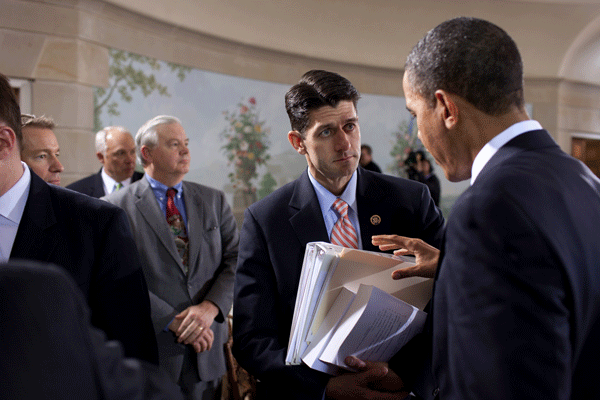
President Barack Obama talks with Rep. Paul Ryan, R-Wisc., during a bipartisan meeting on health insurance. (Official White House Photo by Pete Souza)
CURWOOD: Now Congressman Paul Ryan has released his financial records and the Washington Post found that his family is invested in some companies that lease rights to oil, gas, mineral and timber resources. How much of this is a conflict of interest in your view.
NAYAK: We think it's a major conflict of interest. In fact the League of Conservation Voters ran an ad in Paul Ryan's congressional district last year, hitting him on this very issue, when the report first came out, which is that not only is Paul Ryan's family invested in owning land that they're leasing out to oil and gas companies but those companies are benefitting from the very tax breaks that Paul Ryan is pushing.
CURWOOD: If Congressman Ryan were here he's say, "but wait a second this is only 20-30 thousand dollars a year," out of - what - a third of a million dollars that his family takes in each year, or did last year. It's not very big money these interests.
NAYAK: I think for the average American 20 thousand dollars is a real amount of income. And unfortunately a pretty substantial percentage of what many Americans are making in any given year. And so, I think at the heart of it it speaks to what many Americans are frustrated with Washington, politicians--is that they're much more interested in looking out for themselves, in looking out for the campaign contributors. And Paul Ryan really should've avoided doing things that benefit his business associates.
CURWOOD: Out of all the possible vice presidential candidates that were discussed or out in the press, how does Ryan compare with them on the question of the environment?
NAYAK: I mean I think at the end of the day he is certainly one of the more extreme anti-environmental members that were on Governor Romney's short list. I think you have someone like Tim Pawlenty who used to believe in global warming, has actually been a part of passing clean energy standards when he was governor of Minnesota. So he jumps out as someone who has a much better record on some of these issues. Unfortunately he has distanced himself from some of those, but compared to Paul Ryan who has consistently been part of clean energy, taken nearly a quarter of a million dollars from oil and gas companies. He really would've been one of the world choices that governor Romney could've made and I think that speaks a lot to the governors priorities.
CURWOOD: Navin Nayak is senior vice president and head of campaigns at the League of Conservation Voters. Thank you so much sir.
NAYAK: My pleasure.
Related links:
- Ryan’s 2009 Op-Ed in the Journal Times: “Misplaced Priorities”
- Ryan’s Official Environmental Policy Page
- The League of Conservation Voters scored Ryan at 3% on his environmental record
- Listen to Mitt Romney’s speech on his energy plan from Hobbs, New Mexico August 23, 2012
[Captain Beefheart "When I See Mommy, I Feel Like Mummy" from Shiny Beast (Bat Chain Puller) (Warner bros 1978)]
Power Shift - Massachusetts Energy Conservation
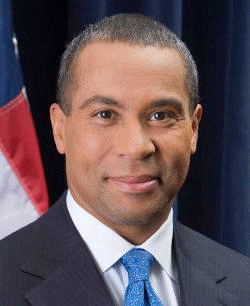
Massachusetts Governor Deval Patrick has been recognized as a national leader in energy efficiency.
CURWOOD: Energy efficiency experts recently graded state governments on their efforts to conserve energy and Massachusetts was at the top of the list. The Bay State is using less energy per person thanks to smart policy and big investments in programs to save energy.
Reporter Jeff Young found out that energy efficiency has been a priority for Massachusetts's governors present and past -- including the one who's now running for president.
YOUNG: The Washington based non-profit Alliance to Save Energy hasn't had much to celebrate in the nation's capital lately, with Congress largely deadlocked on energy policy and do-nothing on climate change. But at the state and city level, it's a different story.
[SOUNDS OF PEOPLE MILLING ABOUT AT EVENT]
YOUNG: The Alliance hosted this breakfast event in Boston recently to recognize a national leader in energy efficiency, Massachusetts Governor Deval Patrick.
PATRICK: What we are trying to do differently in the area of clean and alternative energy is to govern for a generation. How do we make those big choices now -BIG choices now - that are really going to make us stronger over a generation to come. Because everybody's got a stake in us getting this right. Thanks for having me.
[APPLAUSE]
YOUNG: Massachusetts has an ambitious target for 2020: to reduce greenhouse gas emissions 25% below 1990 levels, and by midcentury 80%. Patrick's administration supports clean energy development, including large-scale offshore wind. But much of the state's progress has not come from adding clean energy. It's come from making do with less energy.
[STREET SOUNDS; LOUD TRUCK GENERATOR]
PATRICK: Energy efficiency - you know, the unit not used - is our first fuel. And fortunately, as a result of steps we've taken as policy and behavior we see we can fuel almost all of our growth out into the foreseeable future without any new generation at all, we just have to keep that going.

Massachusetts Governor Deval Patrick has been recognized as a national leader in energy efficiency.
YOUNG: Governor Patrick can rightly claim credit for aggressively pushing efficiency and clean energy investment. But he's also built on important work done over decades by his predecessors, both Democrats and Republicans. Energy efficiency has long been bipartisan in the Bay State, and the state's pragmatic approach shows it's possible to grow an economy and shrink emissions. Doug Foy got a close look at the Massachusetts energy system as both an environmental advocate and a high-ranking state official.
FOY: Massachusetts was the first state to really force utilities to invest in energy efficiency as if it was a power plant. Where now, this year, the utility industry in Massachusetts will spend $600 million dollars on energy efficiency in their customer buildings and that's a big deal.
YOUNG: Foy served under Deval Patrick's predecessor, Republican Governor Mitt Romney. As a Super-Secretary in charge of housing, transportation, energy and environment, Foy helped Gov. Romney develop a climate action plan for the state. The Romney administration also promoted smart growth in housing and transportation and developed what would become the nation's first multi-state effort to cap greenhouse gas emissions--RGGI, the Regional Greenhouse Gas Initiative.
FOY: All of those were part of an effort to build as smart and as frugal and as lean a government as you could. And that was something Gov. Romney felt strongly about.
YOUNG: Did you get the sense that he took climate change seriously as an issue, or was it more just a side effect of these other things he was interested in?
FOY: No, he took it very seriously. I think he and I probably spent more time talking about climate change issues and the climate plan - the climate action plan that we developed - than probably any other single issue we worked on, and we worked on a lot of issues together. And in fact I think felt very strongly that too much time was being wasted trying to debate the science. And not enough time was being spent on, trying to figure out well, what can you do today that makes economic sense anyway.
YOUNG: That was Romney's policy as Governor. Now he faces the politics of a presidential candidacy. And his statements on energy and climate change have been like the campaign trail: all over the map. In June of 2011, Romney told New Hampshire voters it was important to reduce greenhouse gases.
ROMNEY: I believe the world is getting warmer. I can't prove it but I believe based on what I read that the world is getting warmer. And number two I believe that humans contribute to that.
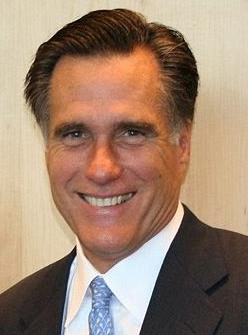
Presidential hopeful and former Massachusetts Governor, Mitt Romney. (Photo: Wikimedia)
YOUNG: But by October 2011 Romney had a different message. Here's what he told this Pittsburgh gathering hosted by coal company Consol Energy.
ROMNEY: My view is that we don't know what's causing climate change on this planet and the idea of spending trillions and trillions of dollars to try and reduce CO2 emissions is not the right course for us.
YOUNG: Pundits quickly labeled this a global warming flip-flop. The Romney campaign did not respond to requests for comment for this story. Governor Romney's Massachusetts record indicates that he struggled with the politics of energy and climate change. For example, Romney's administration shepherded negotiations that brought 10 states into the Regional Greenhouse Gas Initiative, or RGGI. Romney even wrote a strong letter of support for RGGI's cap and trade system for controlling CO2. But in 2005 Gov. Romney declined to sign the final deal on RGGI.
BOWLES: Which I think, uh, some people were confused by.
YOUNG: That's Ian Bowles, who served four years as the Massachusetts secretary of energy and environment under current governor Deval Patrick. Bowles gives Patrick and another former Republican governor William Weld high marks for their efforts on clean energy, efficiency and climate change. But Bowles gives Gov. Romney an incomplete.
BOWLES: He issued a pretty comprehensive climate change plan. And he took climate change seriously. Then about half way through his tenure you know somehow he concluded he no longer wanted to focus on any of those things and stopped paying attention to them.
YOUNG: What do you think happened there?
BOWLES: You know, I'm not a political analyst. Many people would ascribe it to thinking that, you know, a Regional Greenhouse Gas Initiative probably wouldn't play well in the South Carolina primary. But I would not do that because, I don't know.
YOUNG: What Bowles is suggesting is that Governor Romney likely shifted his stance to appeal to conservative voters in a national political atmosphere. Energy and climate change have become charged partisan issues for presidential candidates and in Congress. That's why Bowles thinks governors and mayors will remain the ones most likely to act on clean energy.
BOWLES: You know, the history of American policy development is one of states getting out ahead and then Congress catching up. States like Massachusetts and Connecticut and California are moving ahead aggressively. But I think looking to Congress to lead on these issues, I think is a waste of time at this stage.
YOUNG: Former Romney administration member Doug Foy agrees.
FOY: It would be nice if we had a more thoughtful national energy strategy. We don't.
YOUNG: Foy and Bowles have something else in common. Both are now out of government and in the private sector. Another effect of the state's clean energy investment is a Boston boom in tech startups, capital investors and consultants working on energy efficiency. Bowles' investment firm funds clean tech companies. And Foy's consulting company helps cities radically retrofit commercial and institutional buildings to save energy. Foy's mood brightens as talk shifts from national energy politics to cities and the potential for saving energy.
FOY: We need to be fixing entire buildings. We need to go in and do systems-wide improvement. Because that's where you get the biggest bounce for the ounce, the biggest bang for the buck. That's a huge logistics challenge. But what an opportunity - I mean there's unbelievable number of jobs and economic opportunity in that. And over the next 5, or 10 years, we will start to literally transform the energy footprint of entire cities.
YOUNG: As Foy sees it, America's energy future won't be decided by who runs the White House. It's up to those who run the houses, businesses and buildings all around us. For Living on Earth, I'm Jeff Young in Boston.
Related links:
- American Council for an Energy-Efficient Economy
- Alliance to Save Energy
[ Steve Cropper "Big Bird" from Jammed Together (Stax Records 1969)]
CURWOOD: Just ahead - oh, what a tangled web we weave...especially in the world of chemistry. But now, a new internet application is poised to untangle it.
The chemical internet is just ahead...Keep listening to Living on Earth!
[MUSIC Joe Sample "Sunrise" from Carmel (UMG Records 1979)]
Wastewater to Energy

Caption: Workers restore a sewage pipe built in 1905. The wastewater running through here hovers around 65 degrees. King County wants to harness that heat energy to use in buildings. (Photo: Ashley Ahearn)
CURWOOD: It's Living on Earth, I'm Steve Curwood. About 350 billion kilowatt hours of energy are flushed down drains in the form of warm wastewater every year, says the US Department of Energy. And one county in Washington State hopes to be among the first in the nation to try to harness that wasted heat and use it in buildings. Ashley Ahearn of the public media collaborative EarthFix reports.
[CONSTRUCTION SOUNDS FADE UP]
AHEARN: Jessie Israel looks down into an open sewage pipe at a construction site near Discovery Park. She handles resource recovery for King County's Wastewater Utility. Stinky water rushes beneath the construction worker's feet below us. But Israel doesn't think about it as stinky water.
ISRAEL: The vast majority of what's going out to the plant is water from running our laundry, the sink, it's from your shower this morning. We flush a lot of hot water, a lot of energy down the drain and you can see it right here, we're trying to figure out how to capture that and use it in buildings.
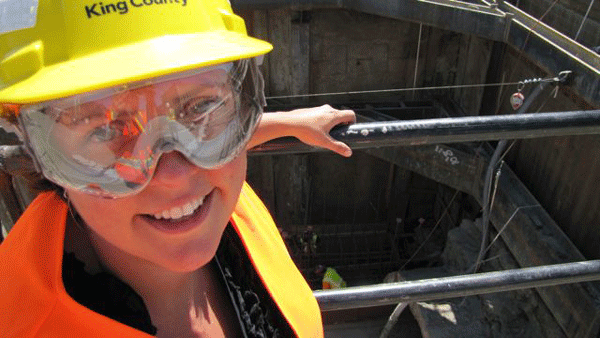
Jessie Israel is the Resource Recovery Section Manager for King County’s Wastewater Utility in Washington. Instead of warm stinky water, she sees untapped energy beneath the streets. (Photo: Ashley Ahearn)
AHEARN: Israel sees that warm sewage water as energy. The average temperature of the water rushing through this pipe, and hundreds of miles of sewage and wastewater pipes in the county, is a pretty constant 65 degrees. King County is looking for partners in the private sector who want to harness that heat and use it in buildings.
ISRAEL: We're essentially going to match-make places where we have pipes full of sewage, full of all that hot water, next to a piece of developable land, with a developer that is a deep green developer who wants to innovate and integrate new technologies.
AHEARN: To be clear: King County is not paying the contractors. They're just offering them access to their pipes. And they are one of the first counties in the nation to do so. Another point of clarification: warm sewage water is not getting funneled around buildings to provide heat.
Lynn Mueller owns a company in Vancouver, BC that installs systems to extract heat energy from wastewater. He says in order to understand this, picture your refrigerator.
MUELLER: So you know how your fridge works, you put warm beer in the fridge, pretty soon the beer is cold and the back of your fridge is warm? You've moved heat from that warm material in the fridge to outside of the fridge and that's basically exactly the same system - it's a heat pump.

Workers restore a sewage pipe built in 1905. The wastewater running through here hovers around 65 degrees. King County wants to harness that heat energy to use in buildings. (Photo: Ashley Ahearn)
AHEARN: So the warm wastewater in the sewage pipe provides the heat - just like the beer in the fridge - and then that heat is used to warm up clean water in separate pipes that circulate around the building. Systems like this have been installed in Japan, China, Canada and parts of Northern Europe - and they're having an impact. One of Mueller's systems went into a building in Vancouver and lowered that building's energy consumption by 75 percent.
MUELLER: We're operating at 600 percent efficiency so every dollar we spend to recover the heat out of the sewer we get six dollars worth of heat out.
AHEARN: Mueller's company sales are projected to jump from three million this year to 50 million next year. But wastewater energy systems won't work on all buildings.
It can be tricky to retrofit buildings that don't already have hot water heat circulating systems.
Jessie Israel with King County says the key is to get developers of new buildings thinking about incorporating this technology early on in the design process - in order to reap big energy savings later.
ISRAEL: 350 billion KWH of energy are lost every year, just flushed down the drain. If we're smart about how we build cities and how we build communities and how we build buildings. Maybe 50 years from now that will be a much smaller number.
AHEARN: I'm Ashley Ahearn in Seattle.
CURWOOD: Our story on turning wastewater to energy comes to us from the public media collaborative EarthFix.
Related links:
- Ashley’s story on the Earthfix website
- King County’s energy ideas page
[MUSIC: Youssou N'Dour "Africa Remembers" from Eyes Open (Columbia Records 1992)]
The Chemical Internet
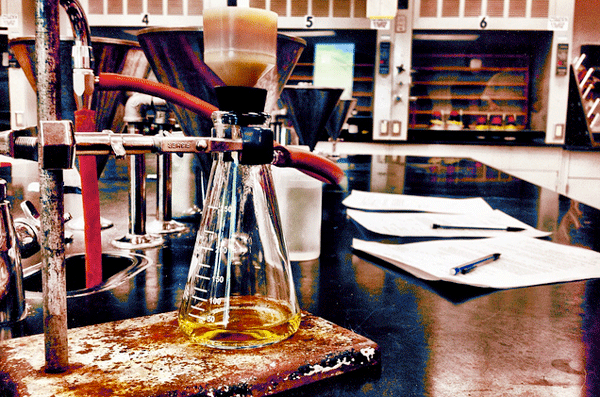
Chemistry the old-fashioned way; the new chemical web could streamline processes. (Photo: Flickr CC/Justin Cooper)
CURWOOD: The Internet has fundamentally changed our world. Now, the creation of another kind of internet--a chemical internet--also has revolutionary potential, not only for the field of chemistry, but for the environmental impact of the chemically-laden world we now live in. Bartosz Grzybowski is a professor of chemistry at Northwestern University in Evanston, Illinois.
Professor Grzybowski and his team have developed software that can track the almost infinite number of possible chemical reactions to find the quickest, cheapest and most environmental safe ways to make things. They nicknamed this software the "chemical internet."
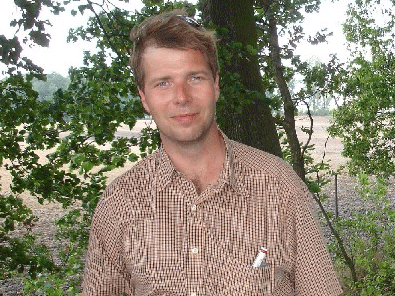
Bartosz A. Grzybowski - K. Burgess Professor of Physical Chemistry and Chemical Systems Engineering, Director of the DoE Non-equilibrium Research Center
GRZYBOWSKI: Imagine a huge network, but instead of computers connected by nodes, we have molecules connected by reactions. And this information has been created not by me, not by my colleagues, but by every chemist that ever lived. So it's a huge mass of chemical reactions connecting molecules existing individually.
What we have done, we collected all this information and hooked it up into a network. Think about it this way: what Google did for the internet--searching for names, addresses, companies, and all that--now we, by having created this chemical internet, what we're doing is a sort of a chemical Google that allows a very different way of looking at chemistry, analyzing chemistry, finding optimal synthetic pathways, new ways of making drugs.
So it's a global view on chemistry, and it's based not on the knowledge of a single chemist--not on my expertise, not on the expertise of any of my colleagues, but on the expertise of every chemist who ever lived.
CURWOOD: As I understand it, there are some seven million different substances that you have linked by knowledge, the reactions that get you from one to another, what do you do with all of that?
GRZYBOWSKI: So let me give you one example. The classical activity of a chemist is to design a synthetic pathway that leads to a molecule like a drug. Now the way it's typically done is you take this complex molecule that you wish to make, you go one synthetic step back, and then you, let's say, have a smaller precursor and then you think, 'Oh, what I do is this molecule,' and you go sort of one step, one step, one step backwards until you reach molecules that you can buy from which you can start your synthesis.
Now, the problem is that if you can imagine a huge highly connected network, one step away you have, let's say, one hundred possibilities because all these molecules have many multiple ways of making them. Two steps away, you'll have something like ten to the third. Three steps away you'll have something like ten to the sixth. By the time you reach six, seven steps, we're talking on the order of possible ways of making this drug approaching much higher than the U.S. debt, and approaching the age of the universe. So let's say something on the order of ten to the twentieth.
Now, out of these ten to the twentieth pathways, the chemist will always strive to find the most optimal one, the most economical one. But the chance of doing this just by human expertise is virtually nil. You simply cannot memorize, you simply cannot consider that many routes leading to this drug molecule. Fortunately, computers and graph theory tools have become powerful enough that you can script this to explore all the possible pathways and choose the one that is really the optimal one.
So all together, what we're doing with this, we're finding pathways that no human, just by the limitations of our brain, no human will ever be able to explore and consider.
CURWOOD: So tell me about the potential that your chemical internet has for what we call green chemistry these days?
GRZYBOWSKI: Aha! And this is very frustrating. When you do it as a chemist, imagine you go this one step back, one step back, one step back, and five steps, after two weeks of hard labor, going to the library, checking the sources and all that, you discover that one of your starting materials is regulated by the EPA. Not good, because then you have to start from scratch.
So, now, the computer, the algorithms I told you about, the ways of finding optimal synthetic pathways, it's just a quicker way to specify, 'I don't want to use this molecule because it kills the fish, this molecule because it goes into the soil, this molecule because something else, and please find me the optimal synthetic pathway without using molecules that are dangerous to the environment.'
CURWOOD: And what about downstream? In other words, if a chemical gets put together, what can your chemical internet tell us about what effects it might have after it's been made and dispersed in the environment?
GRZYBOWSKI: This is something that goes into what we call machine learning. So think about this way: how do we learn about a chemical being toxic or being reactive towards something else? Well, we learn by example and by similarity of one compound to the other.

Chemistry the old-fashioned way; the new chemical web could streamline processes. (Photo: Flickr CC/Justin Cooper)
What we can do, having all the collective knowledge ever created in chemistry, we can train the computer to extract certain patterns automatically, and these patterns are then based not on our individual experience, but on the experiences of everything that was used to train the computer, meaning every single reaction ever performed. So it is quite powerful, and it's very, very predictive.
CURWOOD: Who gets access to your algorithms? Who has access now to the chemical internet?
GRZYBOWSKI: Now, of course, it took about a decade and lots of money and lots of investment and all that stuff, so when we deal with companies, this is not for free. We sell the software. But we're keeping a healthy balance, I hope, between being commercial in our business relations, and giving at least some modules of it to students who can use it and learn it.
CURWOOD: What about a terrorist who wants to figure out a way to make a bomb from completely innocuous materials that would be very easy to move around or purchase?
GRZYBOWSKI: Oh yes, and now you're bringing up one customer that I wanted to avoid, but one of our customers is the U.S. government. Well, in this entire network of chemical compounds, some of them are nerve gases, like VX, some of them are chemical weapons of sorts. And if this technology gets into the hands of the bad guys, they could use it to optimize the synthesis of their chemical weapons, right?
So we reversed the problem, and we started asking the question: Look, if somebody wishes to make a chemical weapon in a way that would not be detected by the government, what would be the optimal strategy to evade the existing regulatory strategy by the government? And initially our hope was that it would not be possible because, of course, the U.S. government is monitoring everything in gory detail.
You can imagine that by searching this huge network, we found so many loopholes that it became scary. So then we went to the Pentagon, and they were genuinely moved by and concerned by what they saw. So we are now developing this software and this is one of the customers that we'll just give the software to and they'll be able to monitor the production, the synthetic pathways leading to chemical weapons in a much better, much more secure way.
CURWOOD: The invention of the internet--the digital internet--radically changed our lives. How might the world look different now with this chemical internet?
GRZYBOWSKI: Well, imagine that we don't have to use toxic chemicals, that we can do things instead of doing five reactions, we can do just one reaction at a fraction of the cost, we can synthesize drugs a more efficient, faster way. So it's a global view on chemistry, it's going to streamline and optimize the discipline. It's going to be a very, very useful tool.
CURWOOD: Bartosz Grzybowski is professor of chemistry at Northwestern University in Evanston, Illinois and calls his chemical internet, Chematica. Thank you so much for taking this time with us today.
GRZYBOWSKI: Thank you.
Related link:
The Grzybowski Group
[MUSIC: Christian Scott "Van Gogh" from Christian aTunde Adjuah (Concord Music 2012)]
Bounty
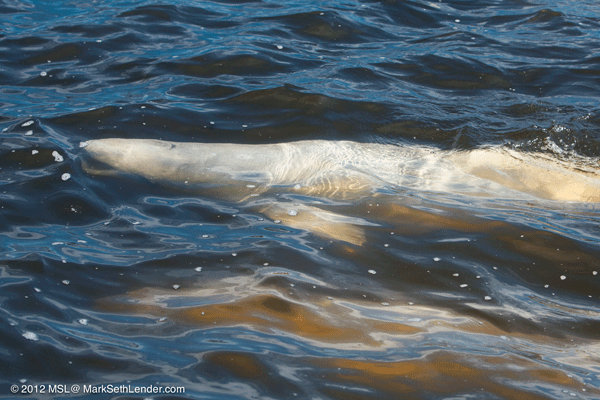
Two Beluga whales swim underwater. (Photo: MarkSethLender.com ©)
CURWOOD: Nature can be disquieting at times. That was the case when writer Mark Seth Lender visited Hudson Bay in Canada. There, whales sometimes strand themselves. But as Mark sees it, in nature, life and death are inseparable.
(SEAGULLS CALLING)
LENDER: Beluga Whale fetches up on the point, rides in the slosh of the riptide where the beach stones clash, Slip slide... slip slide... and the wind groans.
Gray Ghost of a White Whale, he was. Had he lived he would have turned white as a snow bear though now he never will. Gray is the only color he will ever know; gray as a cloud when the light goes.
Perhaps he tangled and drowned pulled down by net or anchor line. Perhaps he was trapped in the shallows on a sandbar and the day did the life out of him, burnt offering to the sun. Or maybe he swallowed something that harmed him. For there are no wounds. Not a mark. No violence defiled him. The mystery dies inside him.
And the tide rolls out; and the wind subsides; and the end of the end arrives.
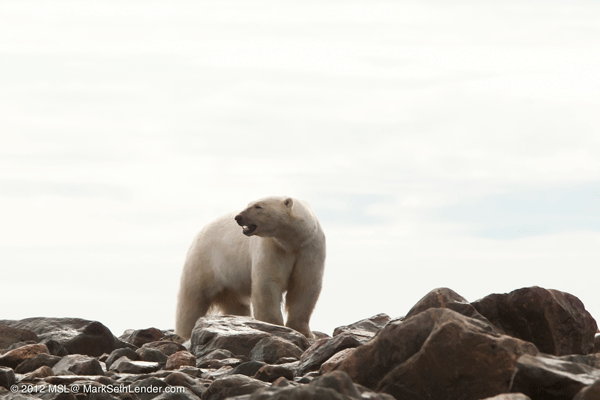
A polar bear arrives on One Bear Point.(Photo: MarkSethLender.com ©)
From the Bay, from tundra from the leeward side of the shore, polar bears come. They come to pay their respects; whale once flesh now meat and brine. And a hollow place where the light of the eyes once shined. It is all the same to him now, who takes charge and who takes care of him.
(SEAGULLS CALLING)
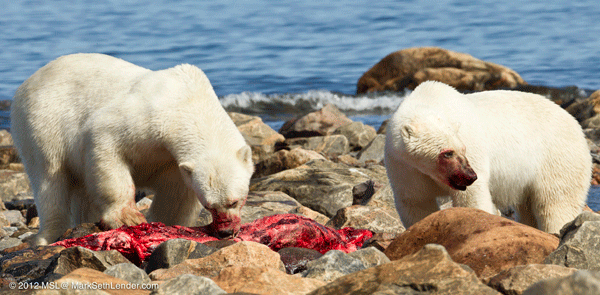
Polar bears feast on a dead Beluga whale which washed ashore in Hudson Bay, Canada. (Photo: MarkSethLender.com ©)
CURWOOD: Mark Seth Lender is the author of Salt Marsh Diary - A Year on the Connecticut Coast. To hear a short interview with Mark about his experience and see some photos, go to our website LOE dot org.
Related links:
- Backstory: Listen to a short interview with Mark Seth Lender about this experience in Hudson Bay, Canada.
- Mark Lender’s website
- See Mark Seth Lender’s short movie “Bounty.” Warning: this movie contains some disturbing content
[MUSIC: John Scofield "Johan" from A Moments Peace (Savoy Jazz 2011)]
CURWOOD: Coming up - peacocks bring in da' noise - but it's inaudible to humans.
Lend an ear to Living on Earth!
ANNOUNCER: Support for Living on Earth comes from Breckinridge Capital Advisors, applying a sustainable approach to fixed income investing, www.breckinridge.com; the Grantham Foundation for the protection of the environment, supporting strategic communications and collaboration in solving the world's most pressing environmental problems, the Gordon and Betty Moore Foundation and Gilman Ordway, for coverage of conservation and environmental change. This is Living on Earth on PRI, Public Radio International.
[MUSIC: Marcus Miller: "Slippin Into Darkness" from Renaissance (Concord Music 2012)]
CURWOOD: You're listening to Living on Earth. And I'm Steve Curwood. In just a minute: how we can break free from ecological decline--the wit and wisdom of David Suzuki. But first this Note on Emerging Science from Christy Perera.
[PEACOCK CALLS]
Science Note: Turning up the volume on the mating dance

A male peacock struts with his eye-spotted plumage held high. (Photo: Jebulon/ Wikipedia)
CURWOOD: The peacock is known for its beautiful plumage and elegant mating dance. New research shows there's more to the dance than meets the human ear.
[SCIENCE NOTE THEME]
PERERA: During the mating season, male peacocks grow a long, elaborate train of feathers. They raise this massive collection of plumage upright and shimmy to attract a mate. To the human ear, this sounds similar to rustling leaves. But researchers at the University of Manitoba found that peacocks actually produce other low-pitched sounds during the dance. These noises, called thrums, fall below 20 Hertz and can't be detected by humans.
Male peacocks create two kinds of thrums--the 'pulse train' and the 'shiver train.'
The 'pulse train' starts at the base of the train feathers and summons females close by. Peacocks create the 'shiver train' by shaking their center feathers and use this to signal potential mates further away.
These brightly feathered birds are the first avian species known to create and respond to sounds below the range of human hearing. Only one other species, a member of the grouse family, has been recorded creating infrasounds like these thrums. But those grouse didn't react to recordings of infrasound, so it's unlikely they use the sounds for communication.
Biologists suspect that if peacocks can rumble, other birds can too. And thanks to this research, it's clear the mating dance is music to a bird's ears.
That's this week's note on emerging science. I'm Christy Perera.
Related link:
The University of Manitoba studied the mating sounds of peacocks
[SCIENCE NOTE THEME]
The Legacy
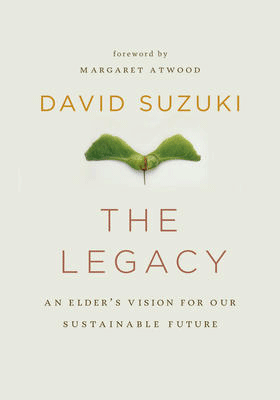
CURWOOD: David Suzuki was a young child when the Canadian government incarcerated his family in a remote camp in the Rockies during World War Two. And because he couldn't speak Japanese like the other interned kids, he went outside on his own and discovered nature. That experience led to an award-winning career in science and popularity as a nature and environmental storyteller on Canadian radio and television. David Suzuki compressed a lifetime of learning and doing into a single lecture and a brief, astonishingly readable and uplifting book called "The Legacy: An Elder's Vision for our Sustainable Future." I spoke with David Suzuki in late 2010 to talk about that vision.
CURWOOD: On the cover of your book "The Legacy: an Elder's Vision for Our Sustainable Future," you have a maple seed, the little thing that spins as it falls to the ground from a maple tree...
SUZUKI: Right. Yeah, to me, that seed symbolizes an opportunity for us to try to copy nature. You know, trees can't get up and try to drop their seeds all over the place, like an animal might, and so they've got to rely on methods to get their seeds spread away. And one method of course is to use the wind and the air, and take your seeds and move them by this helicopter-like motion. One of our problems, I think, is that we try to overwhelm nature with the power of our crude technologies, and oftentimes it creates ecological problems. Nature's had four billion years to evolve basically solutions to the same things you and I have: you know, how to keep from being eaten, what to do if you get sick, how do you get laid, I mean - if we were to look to nature, we could learn a lot with far less deleterious effects.
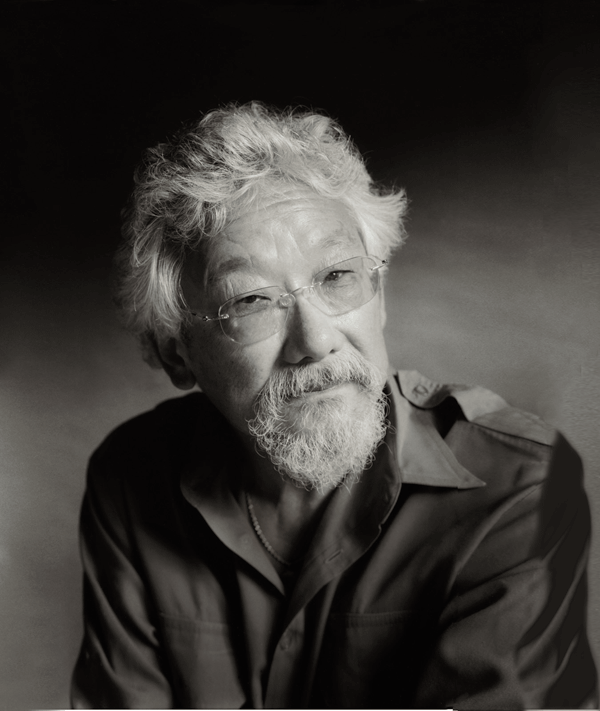
Acclaimed scientist and environmentalist, David Suzuki. (photo: Claire McKinney PR)
CURWOOD: Earlier in your book, you mention that the population of the world has tripled in your lifetime. That's a pretty striking statistic. And what does it tell us?
SUZUKI: It's staggering. We appeared as a species in Africa, maybe 150,000 years ago. We wandered nomadically and gathered food and shelter. It was 10,000 years ago that the big change happened when we discovered agriculture. At the beginning of the agricultural revolution it's estimated that there were about ten million of us on the entire planet. Agriculture heralded a huge shift because we could now grow our food dependably and in only 8,000 years, we increased to another order of magnitude to 100 million people. And in just over 1,800 years, we increased to a billion people. And then in less than 200 years we reached six point nine billion people in 2010. So if you were to plot that on a piece of graph paper, the curve is essentially leaping straight off the page in the last pencil width of time. Nothing can go straight up off the page indefinitely. There's got to be limits, and I fear, that we're going to have some major problems of a big human die-off.
CURWOOD: So, yes, what is the problem of population? What are the consequences that you are concerned about?
SUZUKI: Well, of course it's not just a function of number. It's the amount of stuff that we exploit out of the biosphere, per person. So, if we in North American want to compare ourselves to China or India, you've got to multiply our populations by at least 20, to get our equivalent impact as Chinese or Indians. If you want to compare us to Bangladesh or Somalia, you've got to multiply by at least 60.
And when you look at it that way, then it's clear that it's the industrialized world because of our hyper-consumption. We are consuming over 80 percent of the planet's resources even though we're only 20 percent of the world's population. We are the major predator on the planet.
CURWOOD: Let's talk about the economy. In your book, you quote a couple of economists and retail analysts. One of them is Victor Lebow. You quote him as saying, "Our enormously productive economy demands that we make consumption our way of life. The measure of social status, of social acceptance, of prestige is now to be found in our consumptive patterns." And he goes on to say that, "The greater the pressure upon the individual to conform to safe and accepted social standards, the more he does tend to express his aspirations and his individuality in terms of what he wears, drives, eats, his home, his car, his pattern of food serving, his hobbies."
SUZUKI: Isn't that incredible? This is Victor Lebow who is an industrialist. And what happened was we all came through the terrible depression after the stock market crashed in 1929. What got us out of the depression was World War II, and by the middle of the war, the American economy was blazing, white hot, pumping out guns and tanks and planes and weapons. And of course, it was clear by the mid-1940s that the Allies were going to win the war, and people began to say, 'well, what the heck do we do in peace time?'
And the president of the United States established the council of economic advisors to the president and said, 'how do we make that transition?' And the answer came back - consumption. And Victor Lebow's statement is just the plainest statement that you can get. We've got to make consumption an American way of life. Get people to buy stuff use it up, throw it away, and buy more stuff. And once you introduce the concept of disposability, use something once and throw it away, you've got a perfect system, because you never run out of a market.
But of course, all of that stuff is coming out of the biosphere and the emissions to make that stuff goes back into the biosphere, and when you're finished with these products, you throw it back into the earth, and it's creating an enormous ecological problem. I've got a friend in Toronto, who lives in the outskirts of Toronto in a high-rise apartment building, completely air-conditioned. He goes downstairs into his elevator to his air-conditioned garaged, gets into his air conditioned car, drives down the freeway into the basement of an air conditioned commercial building, up into his office.
That building is connected through a massive set of tunnels to huge shopping centers and food marts. He said, 'David, I don't have to go outside, for days on end!' So who needs nature? We've got our own habitat. And in a city, our highest priority becomes our jobs. We need our jobs to earn money to buy the things that we want. And so the economy becomes our highest priority and that's why we elevate economy above ecology and we think that everything's gotta be done to service the economy. Even though the economy now is so big, it is undermining the very life support systems of the planet! It's using air, water and soil as a garbage can. Each of us now in the industrialized world, carries dozens of toxic chemicals dissolved in our bodies - over a pound of plastic dissolved in our bodies. We are the consequence of this industrial growth, because we have elevated the economy above the very things that keep us alive. And this is madness!
CURWOOD: David, at one point in your book, to explain the relentless need for growth in economies, you compare us to bacteria in a test tube. Can you explain that for us?
SUZUKI: OK, let me give you some background now. We have come to believe that growth is the very definition of progress. You talk to any businessperson or politician and say, 'How well did you do last year?' And within a picosecond, they will talk about growth in the GDP and the economy in profit, jobs or market share. And anything in a finite world cannot grow forever. We live within the biosphere that cannot grow - it's fixed.
And I use the analogy of the bacteria in the test tube for why it's suicidal to look for steady endless growth. Anything growing exponentially has a predictable doubling time. I give you a test tube full of food for bacteria - that's an analogy with the planet - and I put one bacterial cell in and it is us. It's going to go into exponential growth and divide every minute. So at time zero, at the beginning, there is one bacterium. One minute, there are two. Two minutes, four. Three minutes, eight. Four minutes, 16. That's exponential growth.
And at 60 minutes, the test tube is completely packed with bacteria, and there's no food left. When is the test tube only half full? And the answer of course, is at 59 minutes. So, at 58 minutes it's 25 percent full, 57 minutes, 12 and a half percent full. At 55 minutes of the 60-minute cycle, it's three percent full. So if at 55 minutes, one of the bacteria looks around and says, 'Hey guys, I've been thinking, we've got a population problem.' The other bacteria would say, 'Jack, what the hell have you been drinking, man? 97 percent of the test tube is empty, and we've been around for 55 minutes!' And they'd be five minutes away from filling it.
So bacteria are no smarter than humans. At 59 minutes they go, 'Oh my god! Jack was right! What the hell are we going to do, we've got one minute left! Well, don't give any money to those economists, but why don't you give it to those scientists?' And by God, somehow those bacterial scientists in less than a minute, they invent three tests tubes full of food for bacteria. Now, that would be like us discovering three more planet Earths that we could start using immediately. So they're saved, right, they've quadrupled the amount of food in space. So what happens? Well, at 60 minutes, the first test tube is full. At 61 minutes, the second is full, and at 62 minutes, all four are full. By quadrupling the amount of food in space, you buy two extra minutes. And how do you add any more air, water, soil or biodiversity to the biosphere. You can't, it's fixed! And every scientist I've talked to agrees with me. We're already past the 59th minute.
CURWOOD: David Suzuki, this is, I think, one of the most powerful images I have heard of, what some people call the environmental crisis, but I think you probably call it the human crisis.
SUZUKI: It's a human crisis. We're at the center of it. You know, for years, we environmentalists thought that humans are taking too much stuff out of the environment, putting too much waste back into it. And for me, I got a huge shift when I began to work with First Nation, aboriginal people in Canada. And they showed me, there is no environment out there and we are here. We are created by the Earth by the air we breathe, the water we drink, the food we eat. And the energy in our bodies, it comes from the sun. We are the environment, whatever we do to the environment, we do directly to ourselves.
CURWOOD: One of the most fascinating things in your work, David Suzuki, is the discussion you have of the temperate rainforest and the salmon and its connection to it. I wonder if you can share that with us now.
SUZUKI: That is such a wonderful story. One of the rarest ecosystems on the planet is the temperate rainforest. That's the very thin strip that extends all the way from Alaska to California pinched between the Pacific Ocean and the coastal mountain range. The salmon are born in these rivers, they go out to sea, and they grow in the oceans and accumulate the nitrogen from the ocean. And then when they come back the bears, wolves and eagles eat these salmon and they poop and pee all over the woods.
It turns out that the salmon are the biggest pulse of nitrogen fertilizer the forest gets, and the bears are the vectors to carry the nitrogen. They'll fish for these salmon, once they grab one, they hike off up to 150 meters on either side of the river, they eat the salmon - they eat the best part - and they dump the rest of the carcass on the floor of the forest and go back for another one. As soon as they dump the carcass, well, salamanders and slugs and ravens begin to eat it. But the main things are flies that lay their eggs on the carcass. And in a few days the carcass is a seething mass of maggots eating that nitrogen from the ocean. They drop onto the forest floor, and they pupate over the winter and in the spring trillions of flies loaded with nitrogen from the ocean, from the salmon, hatch at the very time that the birds from South America are migrating through the forest on their way to the Arctic nesting grounds. So the salmon come back and they nourish the flies, which feed the birds.
Now, we know the forest, the salmon need the forest. If you clear-cut the forest, the salmon populations plummet or disappear because the salmon need the forest canopy to keep the waters cool. They need the forest to hold the soil so when it rains it doesn't run in and spoil the spawning gravels. And the forest feeds the baby salmon on their way to the ocean. So we know the salmon needs the forest; now we know the forest needs the salmon. So you see this beautiful system where the ocean is connected through the salmon to the forest, and the birds from South America are connected to the northern hemisphere.
Humans come along, and we go 'Oh, well uh, gee there's a lot of salmon here. That's a Minister of Fisheries and Oceans for the fishing fleet. Oh, the trees, well that's a Minister of Forestry. And the eagles, bears and the wolves, that's the Minister of the Environment. Gee, the river that's managed by the Department of Agriculture and the Department of Energy. And the rocks, the mountains, that's the department of mining. So, what is a single interconnected system, we come along, fragment into different bureaucracies and try to manage a complete system through this fractured way of looking at the world. And we will never do it in the right way when we look at it that way.
CURWOOD: So, what's the solution?
SUZUKI: The solution is: our great advantage, what got us to where we are, was our brain. We invented the idea of a future, we could dream of a future in which we could avoid danger and exploit opportunity. I believe foresight was the critical feature that got us out of the plains of Africa to occupy the entire planet. So what do have to do? Imagine a future that is free of danger and full of opportunity. So how about this: how about an America, as Canada was as I was a kid, where you could drink the water out of any lake? Where you can catch a fish and eat it without worrying about chemicals are in it. An America where asthma and cancer rates plummet because we no longer use air, water and soil to dump our toxic chemicals. Let's imagine a future full of opportunity and promise, and then we have a goal that we can work towards, and we know what direction that we want to go in, and everybody will be in it together. This is what we've done in Canada - we've created a vision for one generation away. And when I presented this to the business community, to the mayors of Canadian cities, to the faith community - everybody says,'Well of course, I would love to have a Canada like that.' So, suddenly, we're all together, we're not fighting. We all agree, that's the kind of country we would like to achieve. So anything we do today, we say, 'Okay, that's an interesting proposal, but does that get us closer or further away from that target that we're moving towards?'
CURWOOD: You say, so if Canada can make this a target, so can the United States of America.
SUZUKI: Why not in the United States?
CURWOOD: And what about in the rest of the world?
SUZUKI: Absolutely. I think these movements are all things that we have to begin right away.
CURWOOD: David Suzuki's book is called "The Legacy: an elder's vision for our sustainable future." I spoke with him in December of 2010.
Related link:
David Suzuki Foundation
[MUSIC Anat Fort "Clouds Moving" from And If (ECM Records 2010)]
CURWOOD: Living on Earth is produced by the World Media Foundation. Our crew includes Bobby Bascomb, Eileen Bolinsky, Jessica Ilyse Kurn, Helen Palmer, and Ike Sriskandarajah, with help from James Curwood, Meghan Miner, Gabriela Romanow and Sammy Sousa. This week, we bid a fond farewell to our fabulous interns Annabelle Ford and Annie Sneed. Thanks for all your help. We wish you happy trails.
Jeff Turton is our technical director. Alison Lirish Dean composed our themes. You can find us anytime at L-O-E dot org - and check out our Facebook page it's PRI's Living on Earth. I'm Steve Curwood. Thanks for listening!
ANNOUNCER: Funding for Living On Earth comes from the National Science Foundation, supporting coverage of emerging science. And Stonyfield Farm, organic yogurt and smoothies. Stonyfield invites you to just eat organic for a day. Details at just eat organic dot com. Support also comes from you, our listeners, the Go Forward Fund, the Grantham Foundation for the Protection of the Environment, supporting strategic communications and collaboration in solving the world's most pressing environmental problems, the Gordon and Betty Moore Foundation, and Gilman Ordway - for coverage of conservation and environmental change, and Pax World Mutual and Exchange-Traded Funds, integrating environmental, social, and governance factors into investment analysis and decision making. On the web at pax world dot com. Pax world, for tomorrow.
PRI ANNOUNCER: PRI, Public Radio International.
Living on Earth wants to hear from you!
Living on Earth
62 Calef Highway, Suite 212
Lee, NH 03861
Telephone: 617-287-4121
E-mail: comments@loe.org
Newsletter [Click here]
Donate to Living on Earth!
Living on Earth is an independent media program and relies entirely on contributions from listeners and institutions supporting public service. Please donate now to preserve an independent environmental voice.
NewsletterLiving on Earth offers a weekly delivery of the show's rundown to your mailbox. Sign up for our newsletter today!
 Sailors For The Sea: Be the change you want to sea.
Sailors For The Sea: Be the change you want to sea.
 The Grantham Foundation for the Protection of the Environment: Committed to protecting and improving the health of the global environment.
The Grantham Foundation for the Protection of the Environment: Committed to protecting and improving the health of the global environment.
 Contribute to Living on Earth and receive, as our gift to you, an archival print of one of Mark Seth Lender's extraordinary wildlife photographs. Follow the link to see Mark's current collection of photographs.
Contribute to Living on Earth and receive, as our gift to you, an archival print of one of Mark Seth Lender's extraordinary wildlife photographs. Follow the link to see Mark's current collection of photographs.
 Buy a signed copy of Mark Seth Lender's book Smeagull the Seagull & support Living on Earth
Buy a signed copy of Mark Seth Lender's book Smeagull the Seagull & support Living on Earth

